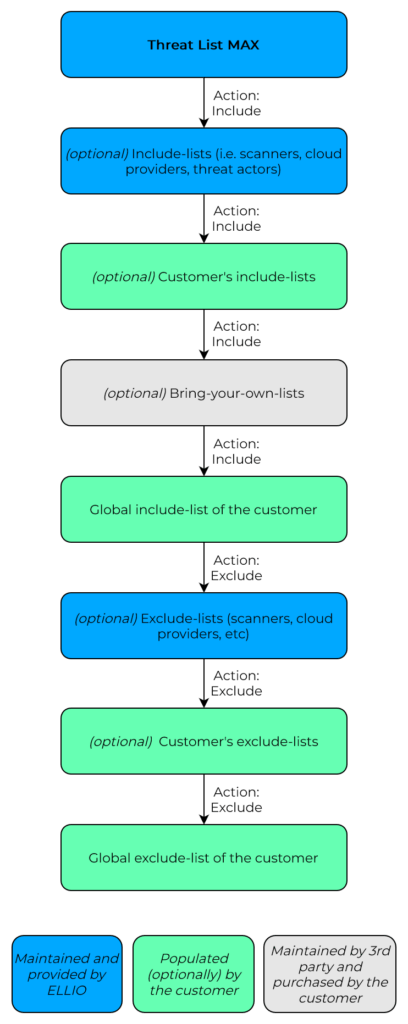This article follows on from the Managing blocklists using a central platform (part1) article.
Previously, we discussed what a deployment is and the various modifications available in the Blocklist Management Platform. Now, let’s take a deeper look at how each stage of deployment creation is executed.
Building Deployments
Understanding how deployments are built and deployed is crucial for effective blocklist management. Here’s a step-by-step overview:

Step 1: Start with a base
Every deployment begins with a base blocklist, such as Threat List MAX, our most extensive and dynamic blocklist. It’s continuously updated through our network of sensors and real-time architecture, making it one of the most comprehensive blocklists available.
Step 2: Add Predefined Include Lists
Next, you can enhance protection by adding predefined include lists. These can include:
- Internet Scanners: Blocking scanners like Shodan and Censys helps conceal your network from public scanning services.
- Specific Cloud Providers: Include IP ranges from cloud providers known to host malicious activities.
- Threat Actor IPs: Predefined lists of IPs associated with specific threat actors.
Step 3: Incorporate Custom Include Lists
Optionally, you can add custom include lists that you manage. For instance:
- Threat Intelligence Feeds: Integrate feeds from trusted sources that identify malicious IPs.
- Sector-Specific Threats: Add IPs relevant to your industry or organization.
These lists can be applied to multiple deployments, offering flexibility and control over your security measures.
Step 4: Integrate Bring-Your-Own-Lists
If you have existing blocklists from other sources, you can integrate them into the Blocklist Management Platform. Whether they’re proprietary lists or paid subscriptions, we’ll manage and distribute them, ensuring consistent application across your network.
Step 5: Apply the Global Include List
Each organization has a Global Include List, a default list applied to all deployments. It’s ideal for adding IPs you consistently want to block across your entire infrastructure. For smaller organizations, this might be the primary method of adding custom blocks.
Step 6: Execute Predefined Exclude Lists
Select from predefined exclusion lists to prevent blocking critical services. Examples include:
- Security Service Providers: Exclude IPs from services like ZScaler or Palo Alto Networks to ensure their scanners aren’t blocked.
- Government Agencies
- Emergency Services
Step 7: Execute Custom Exclude Lists
Create multiple custom exclusion lists tailored to specific deployments. For example:
- Data Centers: Exclude IPs from your data centers conducting legitimate scanning or operations.
- Business Partners: Ensure seamless communication with partners by excluding their IPs.
Step 8: Execute Global Exclude List
Similar to the Global Include List, the Global Exclude List ensures specified IPs are never blocked across any deployment. It’s perfect for whitelisting critical infrastructure or services essential to your operations.
Exclusion Takes Precedence
In our deployment process, exclusions always take precedence over inclusions. This means that if an IP address appears in both an include list and an exclude list, the IP will not be included in the deployment—it won’t be blocked. For example, if you add IP ‘1.1.1.1’ to both the global include and global exclude lists, the IP will not appear in any deployments.
This approach aligns with cybersecurity best practices, where avoiding false positives is crucial to maintaining operational integrity.
In the next part we are going to take a look at how the Blocklist Management Platform integrates into the NOCs and SOCs workflows and also take a look at a few examples.
Useful links
- Try ELLIO: Blocklist Management with a 7day trial.
- Find out out ELLIO: Threat Intelligence to reduce alert fatigue and speed up threat hunting.
- Use a free ELLIO IP Lookup to check suspicious IPs.
- Explore ELLIO: Threat List MAX, the largest and most dynamic IP blocklist on the market, compatible with all popular next-gen firewalls.
- Download ELLIO Free Community IP Blocklist.
About ELLIO
ELLIO is a leading expert on mass exploitation, cyber deception, and opportunistic reconnaissance, delivering real-time, accurate threat intelligence to automate triage and reduce alert fatigue in SIEM, SOAR, TIP, accelerate incident response and threat hunting. ELLIO also offers the largest and most dynamic threat lists (blocklists) and blocklist management platform to strengthen perimeter and firewall defences. More about ELLIO at https://ellio.tech



Qc1vBuzEWOx
BWYMWkZneD6
c3qxchKj4I6
ZgoIkhiwCTR
Stake Online Casino gameathlon.gr is one of the leading crypto gambling since it integrated crypto into its transactions early on.
The online casino market is evolving and there are many options, not all online casinos provide the same quality of service.
In the following guide, we will examine the best casinos you can find in Greece and what benefits they provide who live in Greece.
Best online casinos of 2023 are shown in the table below. The following are the highest-rated casinos as rated by our expert team.
When choosing a casino, it is important to check the licensing, gaming software licenses, and data security policies to confirm security for users on their websites.
If any of these factors are absent, or if it’s hard to verify them, we do not return to that site.
Gaming providers also play a major role in selecting an online casino. As a rule, if the previous factor is missing, you won’t find reputable gaming companies like NetEnt represented on the site.
The best online casinos offer both traditional payment methods like Visa, and they should also offer digital payment services like Skrill and many others.
Self-harm leading to death is a complex phenomenon that affects countless lives around the globe.
It is often connected to mental health issues, such as anxiety, hopelessness, or addiction problems.
People who struggle with suicide may feel overwhelmed and believe there’s no other way out.
how-to-kill-yourself.com
We must spread knowledge about this subject and help vulnerable individuals.
Early support can reduce the risk, and reaching out is a brave first step.
If you or someone you know is struggling, don’t hesitate to get support.
You are not alone, and help is available.
Taking one’s own life is a serious phenomenon that impacts millions of people worldwide.
It is often connected to psychological struggles, such as bipolar disorder, hopelessness, or addiction problems.
People who consider suicide may feel overwhelmed and believe there’s no solution.
how-to-kill-yourself.com
Society needs to raise awareness about this matter and support those in need.
Prevention can save lives, and talking to someone is a crucial first step.
If you or someone you know is in crisis, get in touch with professionals.
You are not without options, and help is available.
On this platform, you can find a great variety of casino slots from leading developers.
Users can try out traditional machines as well as modern video slots with vivid animation and interactive gameplay.
Whether you’re a beginner or a casino enthusiast, there’s always a slot to match your mood.
play casino
The games are available anytime and designed for desktop computers and smartphones alike.
No download is required, so you can get started without hassle.
The interface is user-friendly, making it convenient to explore new games.
Sign up today, and enjoy the thrill of casino games!
Here, you can access a wide selection of casino slots from top providers.
Players can enjoy classic slots as well as feature-packed games with high-quality visuals and exciting features.
Whether you’re a beginner or a seasoned gamer, there’s a game that fits your style.
play casino
Each title are ready to play 24/7 and optimized for desktop computers and smartphones alike.
You don’t need to install anything, so you can start playing instantly.
Platform layout is intuitive, making it simple to find your favorite slot.
Register now, and discover the thrill of casino games!
Here, you can access lots of casino slots from leading developers.
Players can experience traditional machines as well as new-generation slots with high-quality visuals and interactive gameplay.
Even if you’re new or a casino enthusiast, there’s always a slot to match your mood.
slot casino
Each title are ready to play 24/7 and designed for laptops and tablets alike.
You don’t need to install anything, so you can get started without hassle.
Site navigation is user-friendly, making it simple to find your favorite slot.
Register now, and enjoy the world of online slots!
This website, you can discover lots of online slots from top providers.
Visitors can try out retro-style games as well as modern video slots with vivid animation and interactive gameplay.
Whether you’re a beginner or an experienced player, there’s a game that fits your style.
casino slots
Each title are available anytime and compatible with laptops and mobile devices alike.
All games run in your browser, so you can jump into the action right away.
Site navigation is intuitive, making it convenient to browse the collection.
Sign up today, and enjoy the world of online slots!
This website, you can access lots of online slots from famous studios.
Users can experience retro-style games as well as new-generation slots with vivid animation and bonus rounds.
Whether you’re a beginner or a casino enthusiast, there’s always a slot to match your mood.
casino slots
Each title are instantly accessible anytime and optimized for PCs and smartphones alike.
You don’t need to install anything, so you can get started without hassle.
Site navigation is user-friendly, making it simple to explore new games.
Register now, and dive into the world of online slots!
On this platform, you can discover lots of casino slots from famous studios.
Users can enjoy classic slots as well as new-generation slots with high-quality visuals and bonus rounds.
Even if you’re new or a casino enthusiast, there’s something for everyone.
play aviator
Each title are available anytime and designed for laptops and tablets alike.
All games run in your browser, so you can get started without hassle.
The interface is easy to use, making it simple to explore new games.
Join the fun, and enjoy the world of online slots!